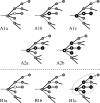The effectiveness of contact tracing in emerging epidemics
- PMID: 17183638
- PMCID: PMC1762362
- DOI: 10.1371/journal.pone.0000012
The effectiveness of contact tracing in emerging epidemics
Abstract
Background: Contact tracing plays an important role in the control of emerging infectious diseases, but little is known yet about its effectiveness. Here we deduce from a generic mathematical model how effectiveness of tracing relates to various aspects of time, such as the course of individual infectivity, the (variability in) time between infection and symptom-based detection, and delays in the tracing process. In addition, the possibility of iteratively tracing of yet asymptomatic infecteds is considered. With these insights we explain why contact tracing was and will be effective for control of smallpox and SARS, only partially effective for foot-and-mouth disease, and likely not effective for influenza.
Methods and findings: We investigate contact tracing in a model of an emerging epidemic that is flexible enough to use for most infections. We consider isolation of symptomatic infecteds as the basic scenario, and express effectiveness as the proportion of contacts that need to be traced for a reproduction ratio smaller than 1. We obtain general results for special cases, which are interpreted with respect to the likely success of tracing for influenza, smallpox, SARS, and foot-and-mouth disease epidemics.
Conclusions: We conclude that (1) there is no general predictive formula for the proportion to be traced as there is for the proportion to be vaccinated; (2) variability in time to detection is favourable for effective tracing; (3) tracing effectiveness need not be sensitive to the duration of the latent period and tracing delays; (4) iterative tracing primarily improves effectiveness when single-step tracing is on the brink of being effective.
Conflict of interest statement
Figures




References
-
- Fenner F, Henderson DA, Arita I, Ježek Z, Ladnyi ID. Smallpox and its eradication. Geneva: World Health Organization; 1988.
-
- Ferguson NM, Donnelly CA, Anderson RM. Transmission intensity and impact of control policies on the foot and mouth epidemic in Great Britain. Nature. 2001;413:542–548. - PubMed
MeSH terms
LinkOut - more resources
Full Text Sources
Miscellaneous

